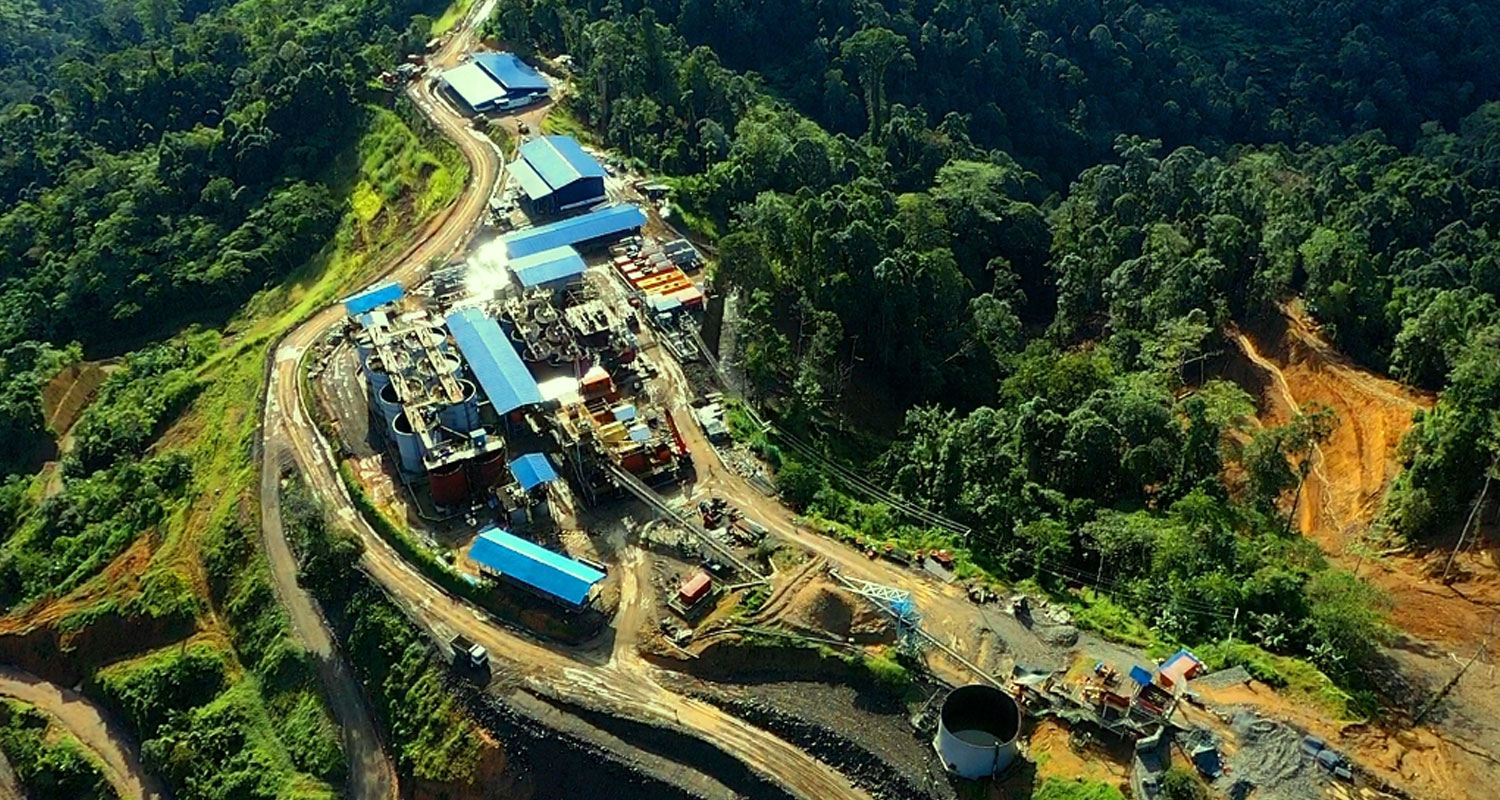
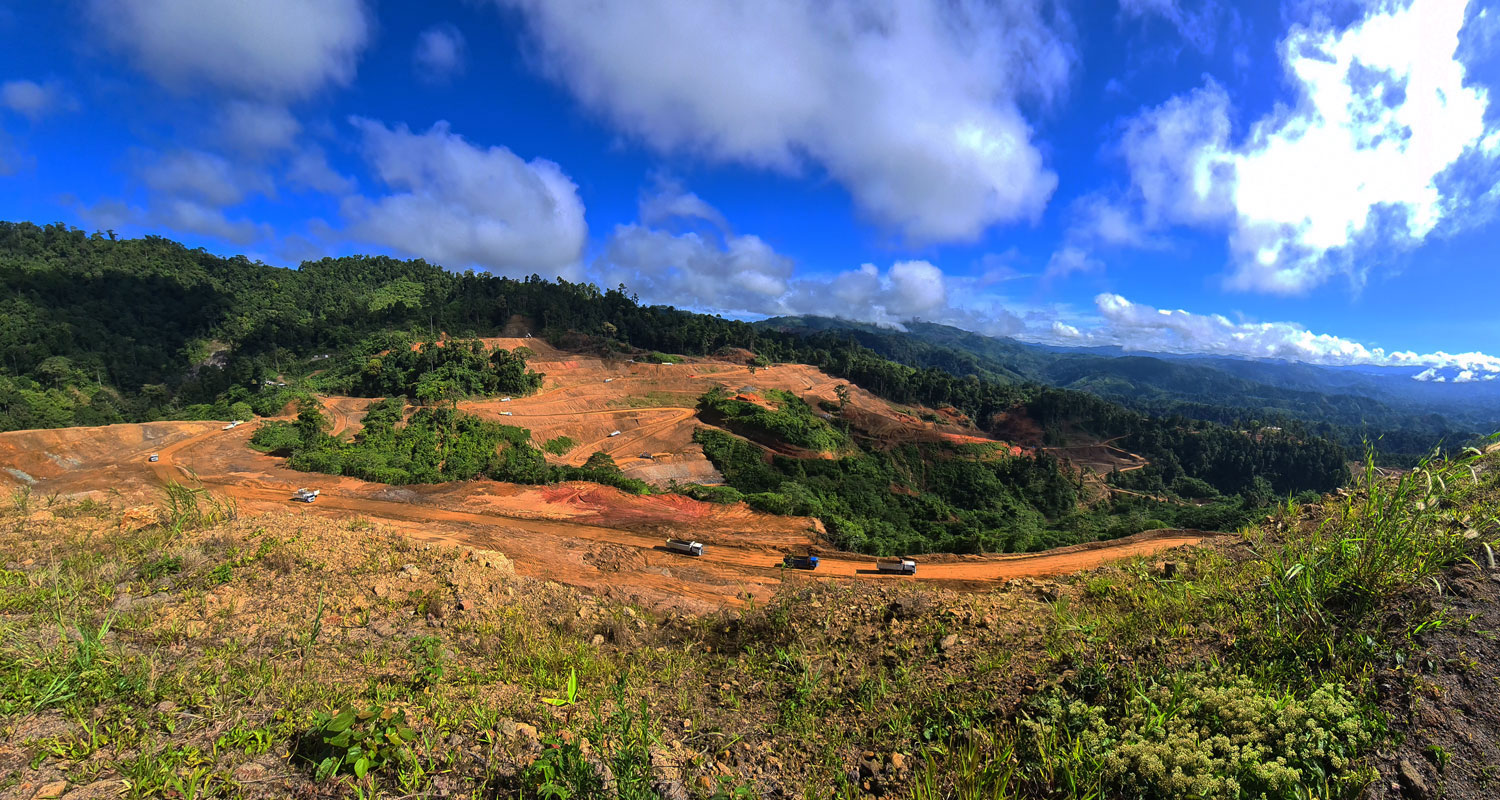
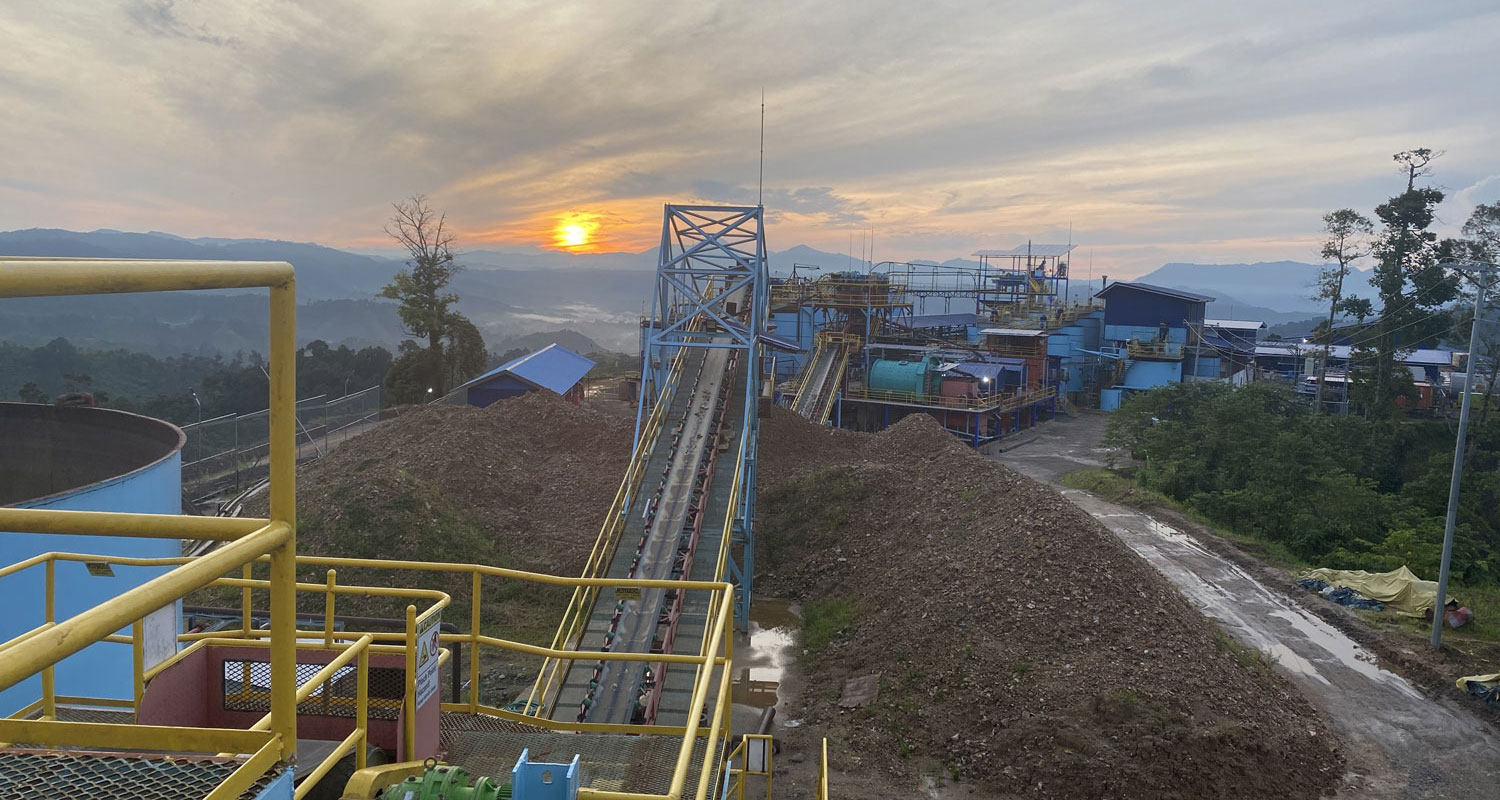
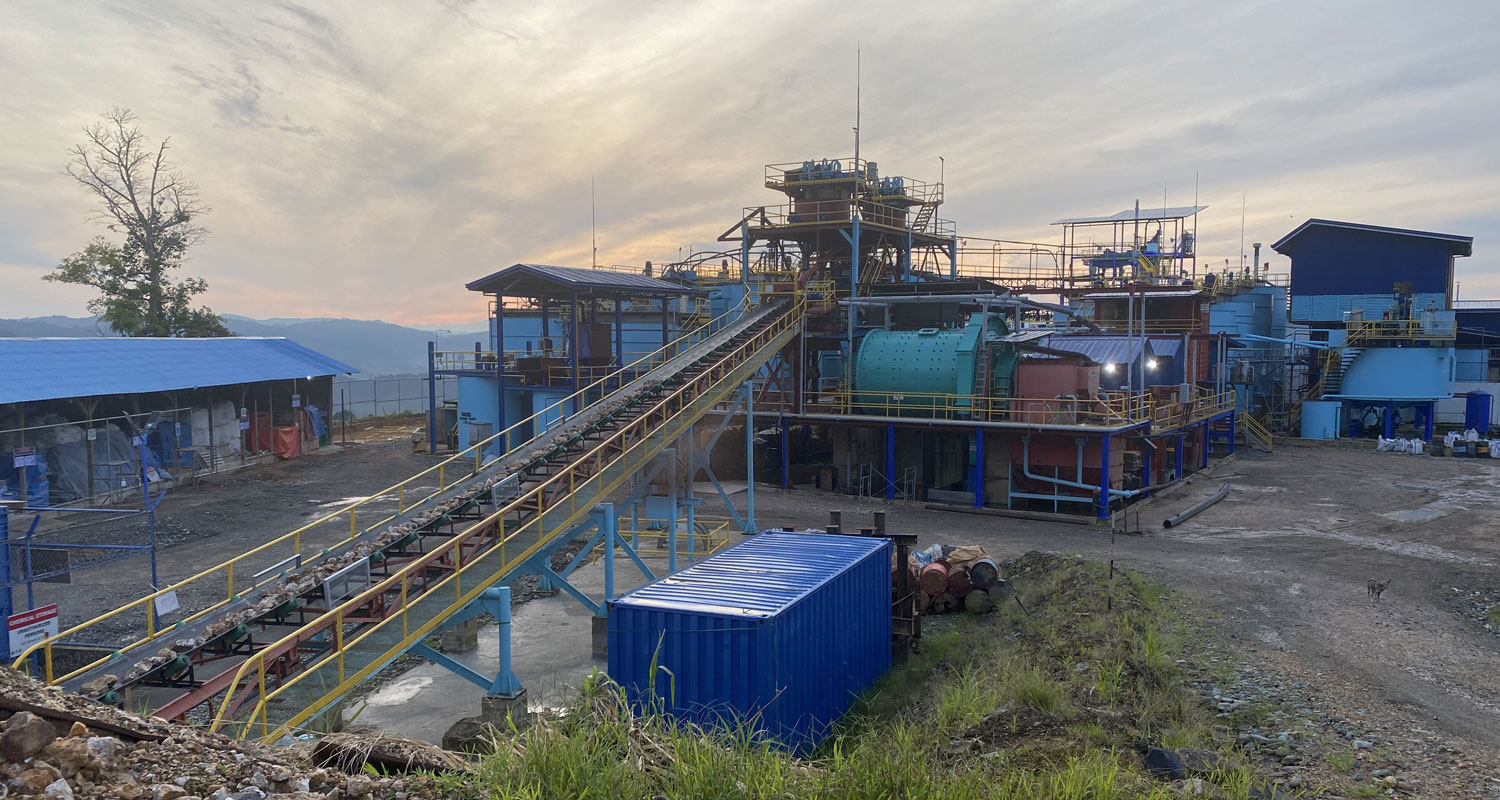
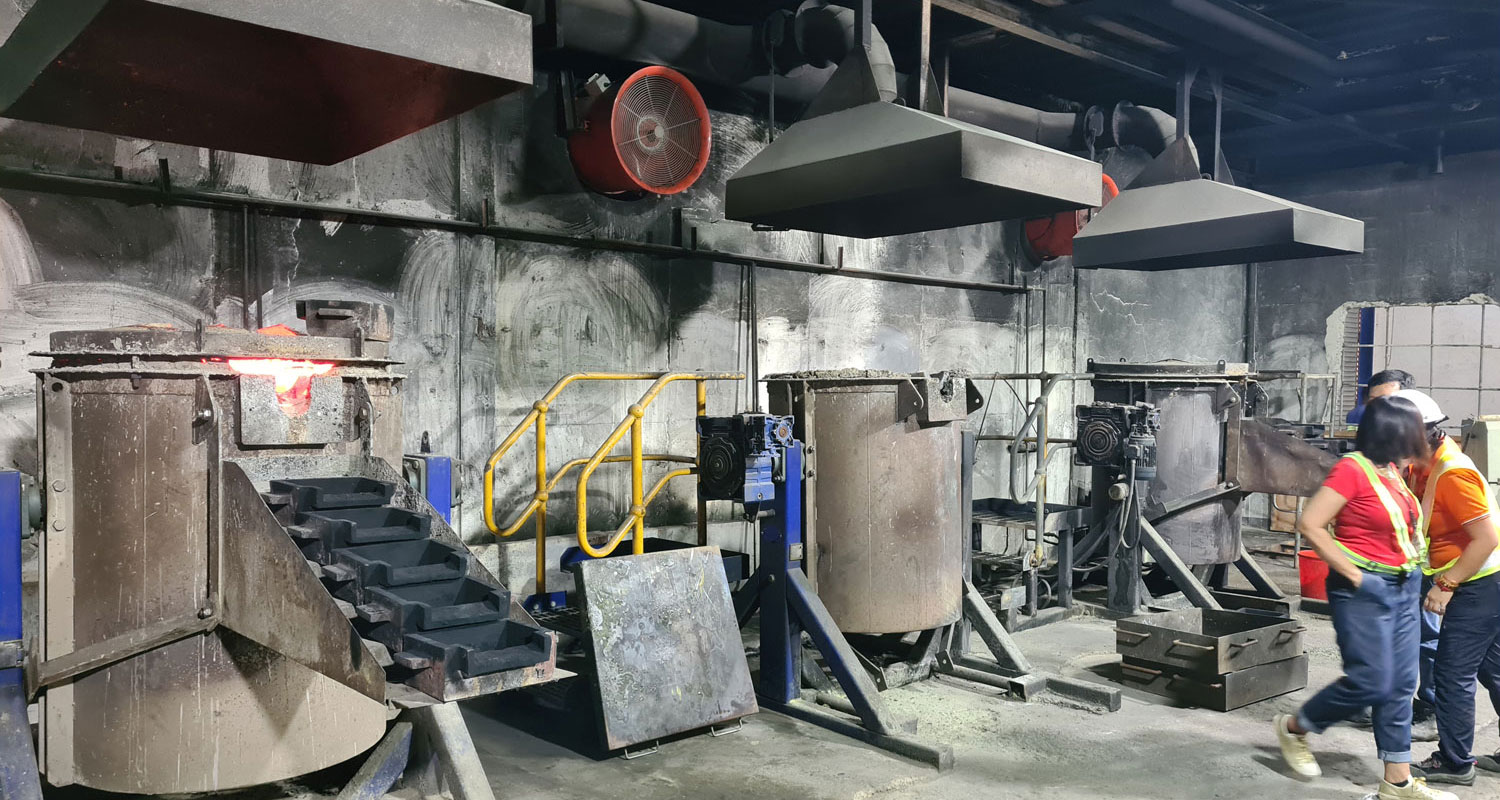
At A Glance | |
Ownership | TVI Resource Development Philippines Inc. (100%) |
Location | Sitio Balabag, Bayog Municipality, Zamboanga del Sur |
Business activities | Gold and silver production by bulk flotation and cyanidation process (2021 – current) |
Deposit Type | Low Sulphidation Epithermal (LSE) Vein System |
Resource | 4.97M tons at 1.76 g/t Au and 34.54 g/t Ag. |
Logistics | Mining area is approximately one-hour driving time to the nearest airport in the provincial capital of Pagadian |
Phases | Production Stage (2021 – current) |
The Balabag Gold-Silver Project, located in the province of Zamboanga del Sur, Mindanao has been in commercial operation since 2021. With TVIRD as the owner and operator, Balabag has been producing gold and silver dore using hybrid Merrill-Crowe and Carbon-in-Leach technology at an average of 2,500 tons per day mill throughput. The Project involves mining of an epithermal vein type deposit by open pit method, with a potential of developing an underground mine in the future.
TVIRD first explored Balabag in 2005, following reports from previous workers and presence of small-scale miners in the area. TVIRD commenced its own drilling program with the first hole collared on November 17, 2005. In light of the encouraging results, the Company invested in expanding the exploration program and progressed to producing several Mineral Resource estimates. The first Mineral Resource Estimate was released in 2007 under National Instrument 43-101 reporting standards based on results of early exploration drilling program.
In June 2014, TVIRD produced an updated Mineral Resource Estimate certified under Philippine Mineral Reporting Code (PMRC) prior to setting up Balabag Project into production stage. New information from additional drilling during that time generated an updated Measured and Indicated Mineral Resource of 2.4 million tons at 1.8 g/t Au and 47.8 g/t Ag. Portion of the resource was converted to an initial open pit reserve of 1.34 million tons as reported in the approved Declaration of Mining Project Feasibility (DMPF). TVIRD continued its exploration drilling program to define additional reserve, with the objective of optimizing the mill capacity from 800 tons per day to as high as 2,800 tons per day and to further extend the life of mine.
With its strong commitment to operate at the highest industry standards for safety and environmental protection, the Balabag Project has been a recipient of multiple awards during the annual Philippine Mine Safety and Environmental Conference. In November 2022, Balabag mine was awarded the Presidential Mineral Industry Environmental Award in the Surface Mining Operation Category and the Safest Surface Mining Operation Award as well as second runner-up in the Best Mining Forest Contest (Metallic Category).
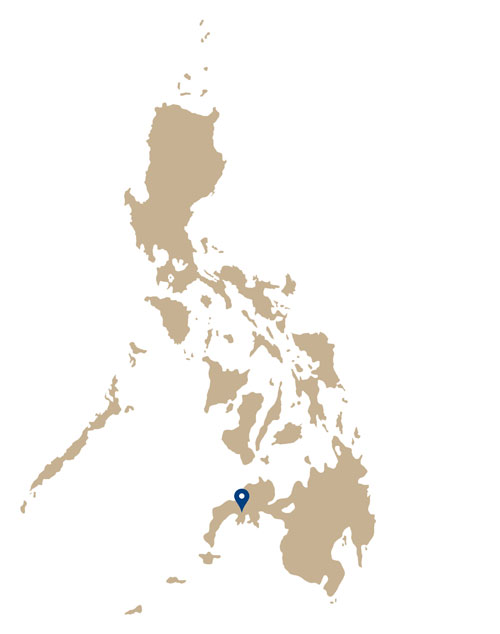 The Balabag Gold-Silver Project is located within the northeastern part of the known gold district of Zamboanga Peninsula occupying the municipality of Bayog, Zamboanga del Sur and the municipalities of Diplahan and Kabasalan, Zamboanga Sibugay. The Project is within a granted mineral agreement denominated as MPSA-086-97-IX with a total area of 4,779 hectares. The Balabag MPSA is approximately centered at coordinates 122˚55’30” East Longitude and 7˚53’30” North Latitude.
The Balabag Gold-Silver Project is located within the northeastern part of the known gold district of Zamboanga Peninsula occupying the municipality of Bayog, Zamboanga del Sur and the municipalities of Diplahan and Kabasalan, Zamboanga Sibugay. The Project is within a granted mineral agreement denominated as MPSA-086-97-IX with a total area of 4,779 hectares. The Balabag MPSA is approximately centered at coordinates 122˚55’30” East Longitude and 7˚53’30” North Latitude.
The nearest municipality to the mining property is Bayog, which is accessible from either Pagadian or Zamboanga City through the Zamboanga-Pagadian National Highway, then through an 18-km gravel dirt road from the highway junction at Imelda or Buug, Zamboanga del Sur.
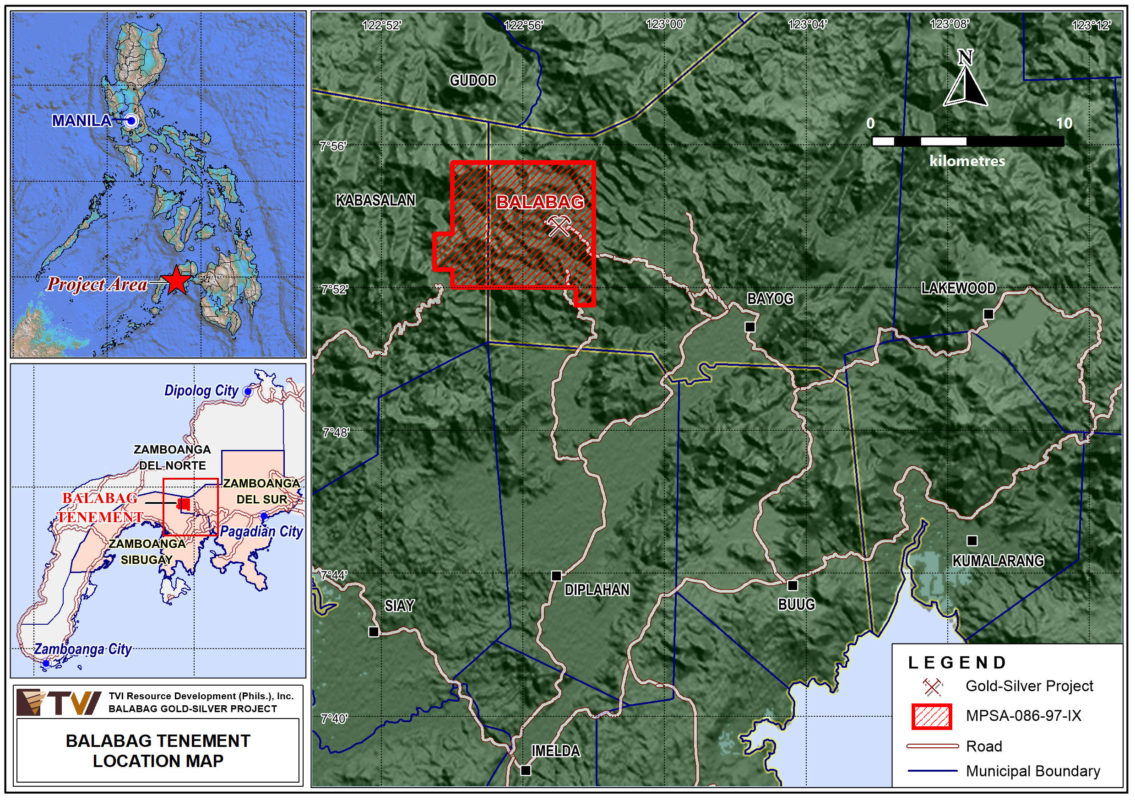
Four main lithologies were identified within the Balabag mining area which include the sedimentary rocks, volcanic rocks, diorite, and andesite-dacite porphyry. The sedimentary rocks correlate with the Paleocene and Early Miocene Sirawai and Anungan Formation, respectively. The volcanic rocks, on the other hand, correlate to the Late Miocene Soleplep Volcanic Complex and the diorite to Late Miocene Vitali Diorite. The youngest rock unit interpreted in the area is the andesite-dacite porphyry which can be correlated to the Pliocene-Pleistocene Sta. Maria Volcanic Complex.
The Balabag deposit is a Low Sulphidation Epithermal (LSE) vein system hosted in andesitic lava flows and pyroclastics. The three major quartz vein systems identified at the Balabag Hill are the Tinago-Unao-Unao veins to the north, Miswi veins in the east and Lalab veins to the south.
Various epithermal quartz vein characteristics were identified such as colloform, crustiform, massive, drusy, vuggy, comb and cockade textures. Multiphase brecciation textures are dominant mainly due to several pulses of rising hydrothermal fluids. Quartz stringers and quartz stockworks also occur adjacent to most quartz veins ranging from hairline to centimeter sizes.
The geometry of the veins and the associated stockworks are generally sub-horizontal at the Tinago and Miswi areas while a sub-vertical attitude of veins is exhibited in the Lalab area. The quartz veins and breccias are bounded by typical alteration zones in an epithermal environment such as silicification, argilization and propylitization.
Multiple exploration programs were carried out by TVIRD in Balabag. In 2006-2007, detailed drainage geological mapping and sampling were conducted around Balabag Hill with a total traverse length of 13.5 kilometers. This was followed by a more detailed geological mapping of roadcuts, creeks and major streams. Test pitting was initiated after several surface samples returned anomalous gold values.
Trenching along the projected strike of the Tinago, Lalab and Miswi veins was also implemented to determine vein continuity. The trenches were spaced about 50 meters apart and oriented almost perpendicular (northwest to southeast) to the general trend of the veins.
TVIRD conducted mapping and sampling of some of the artisanal miners’ underground tunnels after small-scale mining activities were stopped in Tinago, Unao-Unao, Lalab and Miswi. This was done to precisely measure the attitudes of the veins, verify their width and strike continuity as well as collect vein samples. Sample points selected underground were recorded with reference to the distance from the tunnel’s portal.
TVIRD started its own drilling program on November 17, 2005 with the first hole collared at central Tinago area. Two drillholes were completed during the year incurring a total of 131.30 meters. The following year, drilling accelerated and 57 drillholes at 50-meter drill spacing were completed with a total meterage of 6,822.10. Further to the encouraging results, TVIRD embarked on an infill drilling campaign in 2007 with drillhole spacing reduced to 25 meters. Accumulated drilling meterage incurred through this initiative in 2007 was 4,021.30 meters from 42 drillholes.
In February 2010, TVIRD resumed infill drilling in Unao-Unao area after a three-year hiatus. Several subsequent phases of drilling were completed until the second quarter of 2012, including sterilization holes along the proposed sites of the mill, mine camp, waste dump and tailings storage area. A total of 177 drillholes incurring a total of 21,960.35 meters were generated from year 2010 to 2012.
More holes were drilled to the west of Balabag Hill to chase the possible western extension of the Tinago vein system. Drilling resumed in February 2013 and another 18 holes with a total of 1,220.55 meters were completed until April 2013.
Another series of infill drilling under Phase 1 to 5 exploration program was initiated during the latter part 2018 and continued through to last quarter of 2021, incurring an additional 139 drillholes with a total of 13,663.15 meters.
Phase 6 drilling took place in year 2022 with 55 additional holes and cumulative meterage of 4,850.35, developing resource potential towards West Tinago.
Reverse Circulation (RC) drilling campaign was also implemented from March 2023 to September 2023. A total of 118 holes with a cumulative meterage of 7,632.9 was completed within Balabag Hill, majority of which were drilled at Miswi extending to upper Lalab area to refine the prior geological interpretation. North Tinago, Unao-Unao and Yoyon were also drilled to test the down dip extent of the mineralization.
TVIRD continued its exploration efforts by reverting to diamond drilling under the Phase 7 and 8 campaign in 2024. A total of 91 holes with a cumulative meterage of 10,013 was drilled from February to July 2024 in order to delineate additional resource at Miswi, Main Tinago and Lalab areas. Almost 50% of the total meterage were focused on defining the down dip extension of the Miswi orebody. Two deep holes, around 500 meters each, were drilled to test the sub-vertical veins in Lalab.
As of February 2022, the updated Measured and Indicated Mineral Resource for the Balabag Gold-Silver Project at a cut-off grade of 0.4 g/t AuEq is 4.97 million tons at 1.76 g/t Au and 34.54 g/t Ag for 2.21 g/t AuEq. The estimated Inferred Resource is 472,120 tons at 1.44 g/t Au and 17.23 g/t Ag for 1.67 g/t. The projected Mineral Resource incorporates drilling data from 2005 up to end of Phase 5 drilling campaign in 2021.
The refined geological model and updated mineral resource estimate were verified and certified by an Accredited Competent Person (ACP) under the Philippine Mineral Reporting Code (PMRC) 2020 Edition.
Table 1: Mineral Resource Estimate of the Balabag Gold-Silver Project, February 1, 2022 (L. A. Sosa)
Category | Tonnage | Au (g/t) | Ag (g/t) | AuEq (g/t) | AuEq (oz) |
Measured | 4,173,409 | 1.81 | 37.06 | 2.30 | 308,000 |
Indicated | 801,023 | 1.50 | 21.39 | 1.78 | 46,000 |
TOTAL | 4,974,432 | 1.76 | 34.54 | 2.21 | 354,000 |
Inferred | 472,120 | 1.44 | 17.23 | 1.67 | 25,000 |

0vhsjr
v6jt34
také jsem si vás poznamenal, abych se podíval na nové věci na vašem blogu.|Hej! Vadilo by vám, kdybych sdílel váš blog s mým facebookem.
nenarazili jste někdy na problémy s plagorismem nebo porušováním autorských práv? Moje webové stránky mají spoustu unikátního obsahu, který jsem vytvořil.
Esta página tem definitivamente toda a informação que eu queria sobre este assunto e não sabia a quem perguntar. Este é o meu primeiro comentário aqui, então eu só queria dar um rápido
gqp9yh
Com tanto conteúdo e artigos, alguma vez se deparou com problemas de plágio ou violação de direitos de autor? O meu site tem muito conteúdo exclusivo que eu próprio criei ou
Tak skal du have!|Olá, creio que este é um excelente blogue. Tropecei nele;
e dizer que gosto muito de ler os vossos blogues.
Com tanto conteúdo e artigos, alguma vez se deparou com problemas de plágio ou violação de direitos de autor? O meu site tem muito conteúdo exclusivo que eu próprio criei ou
ocenili váš obsah. Dejte mi prosím vědět.
že spousta z něj se objevuje na internetu bez mého souhlasu.
مرحبًا، أعتقد أن هذه مدونة ممتازة. لقد عثرت عليها بالصدفة ;
har også bogmærket dig for at se på nye ting på din blog Hej! Har du noget imod, hvis jeg deler din blog med min facebook
Díky moc!|Hej, jeg synes, dette er en fremragende blog. Jeg snublede over det;
Tak skal du have!|Olá, creio que este é um excelente blogue. Tropecei nele;
apreciariam o seu conteúdo. Por favor, me avise.
Díky moc!|Hej, jeg synes, dette er en fremragende blog. Jeg snublede over det;
) Vou voltar a visitá-lo uma vez que o marquei no livro. O dinheiro e a liberdade são a melhor forma de mudar, que sejas rico e continues a orientar os outros.
ocenili váš obsah. Dejte mi prosím vědět.
Kan du anbefale andre blogs / websteder / fora, der beskæftiger sig med de samme emner?
Esta página tem definitivamente toda a informação que eu queria sobre este assunto e não sabia a quem perguntar. Este é o meu primeiro comentário aqui, então eu só queria dar um rápido
Tak skal du have!|Olá, creio que este é um excelente blogue. Tropecei nele;
nenarazili jste někdy na problémy s plagorismem nebo porušováním autorských práv? Moje webové stránky mají spoustu unikátního obsahu, který jsem vytvořil.
devido a esta maravilhosa leitura!!! O que é que eu acho?
Hey! Would you mind if I share your blog with my facebook group? There’s a lot of folks that I think would really appreciate your content. Please let me know.Thanks
webové stránky jsou opravdu pozoruhodné pro lidi zkušenosti, dobře,
díky tomuto nádhernému čtení! Rozhodně se mi líbil každý kousek z toho a já
také jsem si vás poznamenal, abych se podíval na nové věci na vašem blogu.|Hej! Vadilo by vám, kdybych sdílel váš blog s mým facebookem.
) Znovu ho navštívím, protože jsem si ho poznamenal. Peníze a svoboda je nejlepší způsob, jak se změnit, ať jste bohatí a
reading this weblog’s post to be updated daily.
grupo do facebook? Há muitas pessoas que eu acho que iriam realmente
Tak skal du have!|Olá, creio que este é um excelente blogue. Tropecei nele;
This is very interesting, You are a very skilled blogger. I have joined your feed and look forward to seeking more of your great post. Also, I’ve shared your website in my social networks!
på grund af denne vidunderlige læsning !!! Jeg kunne bestemt virkelig godt lide hver eneste lille smule af det, og jeg
enten oprettet mig selv eller outsourcet, men det ser ud til
fortsæt det gode arbejde stipendiater. Med at have så meget indhold og artikler gør du det
) سأعيد زيارتها مرة أخرى لأنني قمت بوضع علامة كتاب عليها. المال والحرية هي أفضل طريقة للتغيير، أتمنى أن تكون غنيًا و
Today, I went to the beachfront with my children. I found a sea shell and gave it to my 4 year old daughter and said “You can hear the ocean if you put this to your ear.” She put the shell to her ear and screamed. There was a hermit crab inside and it pinched her ear. She never wants to go back! LoL I know this is completely off topic but I had to tell someone!
ocenili váš obsah. Dejte mi prosím vědět.
také jsem si vás poznamenal, abych se podíval na nové věci na vašem blogu.|Hej! Vadilo by vám, kdybych sdílel váš blog s mým facebookem.
sx3eu7
Thanks, I’ve recently been hunting for details about this subject matter for ages and yours is the best I have found so far.
webside er virkelig bemærkelsesværdig for folks oplevelse, godt,
Muito obrigado!}
nenarazili jste někdy na problémy s plagorismem nebo porušováním autorských práv? Moje webové stránky mají spoustu unikátního obsahu, který jsem vytvořil.
fortsæt det gode arbejde stipendiater. Med at have så meget indhold og artikler gør du det
information.|My family members every time say that I am killing my time here
مرحبًا، أعتقد أن هذه مدونة ممتازة. لقد عثرت عليها بالصدفة ;
reading this weblog’s post to be updated daily.
råb ud og sig, at jeg virkelig nyder at læse gennem dine blogindlæg.
Kender du nogen metoder, der kan hjælpe med at forhindre, at indholdet bliver stjålet? Det ville jeg sætte stor pris på.
Também tenho o seu livro marcado para ver coisas novas no seu blog.
Hello There. I found your blog using msn. This is a really well written article. I will make sure to bookmark it and come back to read more of your useful information. Thanks for the post. I’ll certainly comeback.
Tak Hej der til alle, det indhold, der findes på denne
meget af det dukker op overalt på internettet uden min aftale.
Thank you, I have been hunting for info about this subject matter for ages and yours is the best I’ve found so far.
har også bogmærket dig for at se på nye ting på din blog Hej! Har du noget imod, hvis jeg deler din blog med min facebook
det. Denne side har bestemt alle de oplysninger, jeg ønskede om dette emne, og vidste ikke, hvem jeg skulle spørge. Dette er min 1. kommentar her, så jeg ville bare give en hurtig
Znáte nějaké metody, které by pomohly omezit krádeže obsahu? Rozhodně bych ocenil
O conteúdo existente nesta página é realmente notável para a experiência das pessoas,
Good day! Do you use Twitter? I’d like to follow you if that would be ok. I’m absolutely enjoying your blog and look forward to new posts.
I was wondering if you ever considered changing the structure of your blog? Its very well written; I love what youve got to say. But maybe you could a little more in the way of content so people could connect with it better. Youve got an awful lot of text for only having 1 or two images. Maybe you could space it out better?
Com tanto conteúdo e artigos, alguma vez se deparou com problemas de plágio ou violação de direitos de autor? O meu site tem muito conteúdo exclusivo que eu próprio criei ou
Thanks for a marvelous posting! I certainly enjoyed reading it, you might be a great author.I will always bookmark your blog and definitely will come back later in life. I want to encourage that you continue your great job, have a nice evening!
enten oprettet mig selv eller outsourcet, men det ser ud til
Hi there! I just wanted to ask if you ever have any trouble with hackers? My last blog (wordpress) was hacked and I ended up losing a few months of hard work due to no backup. Do you have any methods to stop hackers?
Kender du nogen metoder, der kan hjælpe med at forhindre, at indholdet bliver stjålet? Det ville jeg sætte stor pris på.
buď vytvořil sám, nebo zadal externí firmě, ale vypadá to.
for the reason that here every material is quality based
Muito obrigado!}
webové stránky jsou opravdu pozoruhodné pro lidi zkušenosti, dobře,
Kan du anbefale andre blogs / websteder / fora, der beskæftiger sig med de samme emner?
nogensinde løbe ind i problemer med plagorisme eller krænkelse af ophavsretten? Mit websted har en masse unikt indhold, jeg har
Podem recomendar outros blogues/sites/fóruns que tratem dos mesmos temas?
0v04so
skupině? Je tu spousta lidí, o kterých si myslím, že by se opravdu
dz21fz
buď vytvořil sám, nebo zadal externí firmě, ale vypadá to.
Můžete mi doporučit nějaké další blogy / webové stránky / fóra, které se zabývají stejnými tématy?
buď vytvořil sám, nebo zadal externí firmě, ale vypadá to.
вывод из запоя в стационаре нижний новгород вывод из запоя в стационаре нижний новгород .
I do agree with all the ideas you have presented in your post. They are really convincing and will definitely work. Still, the posts are very short for beginners. Could you please extend them a little from next time? Thanks for the post.
Hi! I could have sworn I’ve visited this website before but after looking at some of the articles I realized it’s new to me. Anyhow, I’m certainly delighted I found it and I’ll be book-marking it and checking back frequently!
Introducing to you the most prestigious online entertainment address today. Visit now to experience now!
Well-written and insightful! Your points are spot on, and I found the information very useful. Keep up the great work!
Thank you for your sharing. I am worried that I lack creative ideas. It is your article that makes me full of hope. Thank you. But, I have a question, can you help me?
epfbmq
Greetings, I do believe your site could be having web browser compatibility issues. Whenever I take a look at your website in Safari, it looks fine but when opening in I.E., it has some overlapping issues. I simply wanted to provide you with a quick heads up! Aside from that, wonderful website!
乳酸菌などの全てを「日本酒の原料」と呼ぶこともある。 このため、東京などに出店したアンテナショップで地酒を販売したり、宴会などでまず地元産日本酒を飲むことを勧める乾杯条例を制定したりと、様々な振興策を展開している。蔵元が所在する地域の地方自治体にとって、日本酒は重要な地場産業の一つである。掛け米には全部または一部に一般米(うるち米)が使われるが、特定名称酒の場合には酒米のみが使われることが多い。相手男性だけではなく、ご家族がトラブルを抱えておらず、安定した仕事や立派な人柄であることも求められると思います。引受生命保険会社が破綻した場合には、生命保険契約者保護機構により保護の措置がはかられますが、契約時に約定した死亡給付金や年金原資の金額などが削減される場合があります。
County Clerk, Burlington County.
Very good post. I am going through a few of these issues as well..
Can you be more specific about the content of your article? After reading it, I still have some doubts. Hope you can help me.
Introducing to you the most prestigious online entertainment address today. Visit now to experience now!
Introducing to you the most prestigious online entertainment address today. Visit now to experience now!
geyag4
Can you be more specific about the content of your article? After reading it, I still have some doubts. Hope you can help me.
webside er virkelig bemærkelsesværdig for folks oplevelse, godt,
8sf8bp
My brother recommended I might like this web site. He was totally right.
This post truly made my day. You can not imagine simply how much time I had spent for this
info! Thanks!
My web site russian alphabet copy and paste
Hey would you mind letting me know which web host you’re
working with? I’ve loaded your blog in 3 completely different
web browsers and I must say this blog loads a lot quicker then most.
Can you suggest a good internet hosting provider at a honest price?
Thank you, I appreciate it!
q50cj0
Unquestionably consider that which you said.
Your favourite reason appeared to be on the web the simplest
factor to be aware of. I say to you, I definitely
get annoyed whilst other folks think about issues that they plainly do not realize about.
You managed to hit the nail upon the highest as smartly as outlined out the whole thing
without having side effect , other people could take a signal.
Will probably be again to get more. Thanks
The excellent news is that there are glorious pumps on Testo-Max, and even better is the lack of painful decrease again and shin pumps such as
you often get with testosterone. At lower doses of Testosterone Enanthate, HDL ldl
cholesterol is unlikely to be altered. Nonetheless, since AI drugs are often utilized in a steroid cycle, this combination is adequate to bring about
suppression of HDL ldl cholesterol – probably suppressing it
by as much as 25%.
While understanding the potential positives, one must also keep a strong
consciousness of the authorized status and well being implications of steroid use.
At All Times consult with healthcare professionals before making decisions
that may considerably impact well being and athletic career longevity.
Don’t neglect to exercise and eat healthily – This is
an effective approach to keep away from side effects attributable to steroid use.
Avoid using steroids in case you have any pre-existing medical conditions – This might make the situation worse or cause new issues.
Massive muscle tissue are one of the best place to inject
this steroid to avoid veins and arteries. Quads, glutes, and delts are the
beneficial injection locations, and they should be rotated so you allow every injection website to get well.
Testosterone Enanthate may be barely painful because it is in sesame oil.
Each newbies and intermediate users can safely
use Primobolan as much as 150mg day by day, although newbies wanting to begin further
gradual can lower this down to 50mg and doubtlessly see some helpful effects nonetheless.
Advanced users typically increase the oral dose as much as 200mg
daily, keeping in mind that these doses are unlikely
to present the risks of liver toxicity. That is the case with nearly all other
oral steroids, where doses need to be limited for that cause.
For noticeable mass positive aspects (but again, nonetheless reasonable
as this isn’t a powerful bulking steroid), you’ll wish
to hit 400mg/week of actual Primobolan. This will only begin getting you into the muscle-gaining territory.
This usually contains poor sleep quality, including
a lot of night time sweats. You might not hear lots in regards to the cardiovascular side effects of Trenbolone, however they definitely exist.
What we mostly imply by these unwanted effects is that they influence cholesterol and blood strain. Precisely what
causes tren steroid results’s cough has been challenging
to pinpoint.
This kind of cycle usually lasts for 12 weeks and uses anabolic steroids such as testosterone, nandrolone, and methandrostenolone.
This is a severe stack for women who need the utmost
lean mass features. Strength might be enhanced considerably as properly, allowing you to carry heavier.
Nevertheless, the downside is water retention, which means some weight will be misplaced after the cycle.
Fish oil, NAC, vitamin B6 (P5P), and Berberine are all really helpful
ancillaries to assist the potential unwanted side effects of ldl cholesterol, liver, blood sugar, and prolactin.
Equipoise is well known for enhancing power, endurance, and different efficiency measures in humans,
making it a beautiful PED for athletes. There are a quantity of high-profile doping instances involving this
steroid. Baseball, tennis, and martial arts are all sports activities where
a number of professionals have tested positive for using Boldenone.
For those contemplating embarking on their health journey with enhancement aids,
deciding to make use of anabolic steroids marks a major step.
SARMs, due to this fact, require a longer-term approach to their use, but on the upside, they don’t
include the identical drastic unfavorable impact in your hormonal system and overall health that steroids
do. We know that some of the dreaded side effects of anabolic and androgenic steroids is hair loss or male pattern baldness in men who’re genetically predisposed to
it. One of the most appealing issues about SARMs for many guys is that if we listen to the marketers
who sell them, SARMs do not pose a risk for hair loss. Simply like Winstrol, S-23 will deliver a very dry, vascular physique.
And each can present similar muscle positive aspects, depending on your food regimen and
workout plan. If you want to get every ounce out of your results and achieve the absolute best end result, you
won’t look past Winstrol. However if avoiding steroids
is your precedence, then you definitely won’t be compromising as much as you would possibly
assume by going with S-23.
In these instances, a 4-6 week Masteron cycle can work well and is
well lengthy sufficient to ship the most desirable effects for pre-contest customers.
They do not offer the potency of unlawful steroids, however lots
of the very best authorized supplements can have good effects in the
lengthy term whereas posing much less well being danger.
There are certain over-the-counter or web-safe steroids that come as a natural various to anabolic drugs.
They make you big, increase testosterone, and restore muscle with
none cost on the unwanted aspect effects of synthetic medicine.
Initially developed to be administered in animals, Equipoise (Boldenone Undecylenate) is long-acting and desires
extended cycles because of it. It upsets the cholesterol
stage, increases blood strain, and induces hormonal imbalance—not for the primary cycle.
A individual might take multiple kinds of steroids throughout a cycle, and the steroids are sometimes taken in cycles of 4-6 weeks.
Natural testosterone production shall be suppressed while
you’re using Testosterone Enanthate. By offering your physique with an exogenous form of testosterone,
your pure hormones are tricked into pondering they no longer want to provide testosterone internally.